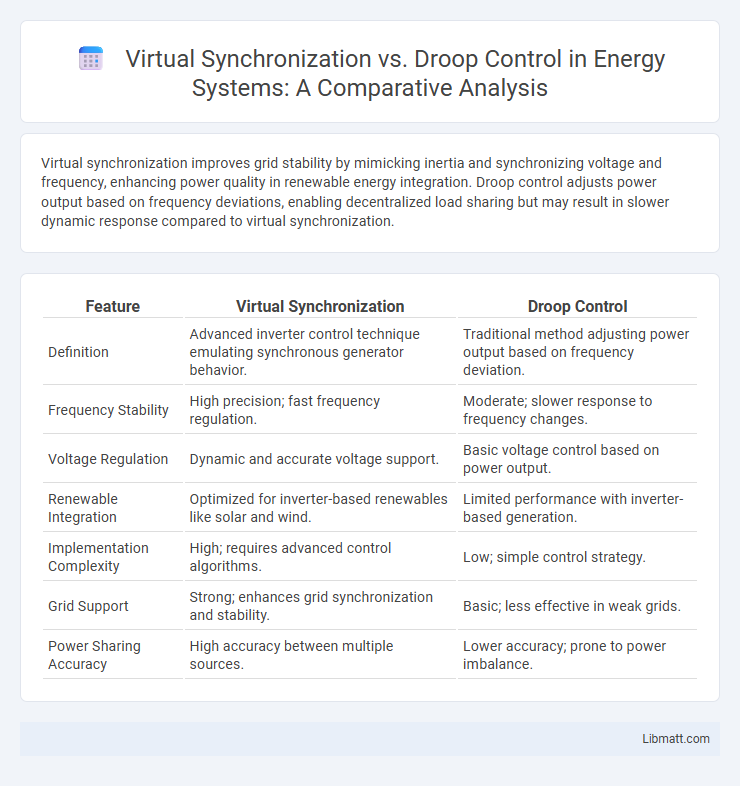Virtual synchronization improves grid stability by mimicking inertia and synchronizing voltage and frequency, enhancing power quality in renewable energy integration. Droop control adjusts power output based on frequency deviations, enabling decentralized load sharing but may result in slower dynamic response compared to virtual synchronization.
Table of Comparison
| Feature | Virtual Synchronization | Droop Control |
|---|---|---|
| Definition | Advanced inverter control technique emulating synchronous generator behavior. | Traditional method adjusting power output based on frequency deviation. |
| Frequency Stability | High precision; fast frequency regulation. | Moderate; slower response to frequency changes. |
| Voltage Regulation | Dynamic and accurate voltage support. | Basic voltage control based on power output. |
| Renewable Integration | Optimized for inverter-based renewables like solar and wind. | Limited performance with inverter-based generation. |
| Implementation Complexity | High; requires advanced control algorithms. | Low; simple control strategy. |
| Grid Support | Strong; enhances grid synchronization and stability. | Basic; less effective in weak grids. |
| Power Sharing Accuracy | High accuracy between multiple sources. | Lower accuracy; prone to power imbalance. |
Introduction to Power Grid Control Methods
Virtual synchronization and droop control represent advanced power grid control methods designed to enhance stability and efficiency in electrical networks. Virtual synchronization mimics the natural inertia of synchronous generators, enabling inverter-based resources to dynamically adjust output frequency and phase, closely emulating traditional rotating machines. Droop control regulates power sharing by adjusting voltage or frequency in response to load changes, facilitating decentralized management and maintaining system reliability in microgrids and renewable energy integration.
Understanding Virtual Synchronization
Virtual Synchronization emulates natural grid dynamics by replicating the inertia and damping effects of synchronous generators, enabling converters to synchronize with the grid frequency more seamlessly than traditional droop control. Unlike droop control, which adjusts power output based on frequency deviations, virtual synchronization provides a dynamic response that enhances system stability and reduces frequency oscillations. Your energy system benefits from improved reliability and resilience through virtual synchronization's ability to mimic physical generator behavior in renewable integration.
Fundamentals of Droop Control
Droop control fundamentally regulates frequency and power output in power systems by adjusting generator output proportionally to frequency deviations without requiring communication between units. It mimics the natural governor response, enabling decentralized load sharing and system stability in synchronous generators. The method balances supply and demand through frequency droops, preventing overloading and maintaining grid reliability.
Operational Principles Compared
Virtual Synchronization control mimics the natural synchronization of synchronous generators by emulating a virtual rotor angle, enabling seamless power sharing and grid stability without relying on frequency measurements. Droop control adjusts the inverter output frequency and voltage proportionally to power deviations, allowing decentralized load sharing but often requiring compensation for steady-state errors. Virtual Synchronization offers faster dynamic response and improved harmonization in inverter-based resources compared to the traditional droop method.
Advantages of Virtual Synchronization
Virtual synchronization offers superior stability and dynamic response in power systems by mimicking synchronous machine behavior through advanced control algorithms. It enhances system robustness against disturbances and enables more accurate load sharing compared to traditional droop control methods. Your grid integration benefits from improved frequency regulation and reduced risk of oscillations, ensuring a more reliable and resilient energy network.
Benefits of Droop Control
Droop Control improves system stability by automatically adjusting power output in response to frequency changes, enhancing load sharing among generators without requiring complex communication. It enables decentralized operation, which simplifies system design and increases resilience to faults. Your energy system benefits from improved reliability and better management of grid fluctuations through this straightforward control strategy.
Application Scenarios and Suitability
Virtual Synchronization excels in microgrid applications and inverter-dominated power systems where precise frequency and phase alignment are essential for stable operation. Droop Control is more suitable for traditional grids and distributed generation with tight load sharing requirements due to its simplicity and robustness under varying load conditions. Your choice depends on whether the priority is seamless synchronization in inverter-based setups or reliable load sharing in conventional power environments.
Stability and Performance Analysis
Virtual synchronization improves stability by mimicking synchronous generator inertia, leading to faster transient response and reduced frequency deviations compared to droop control. Droop control provides decentralized frequency regulation but may exhibit slower dynamic response and larger steady-state errors under load disturbances. Stability analysis shows virtual synchronization enhances damping of oscillations, while performance metrics favor virtual synchronization for maintaining grid voltage and frequency within tighter bounds.
Challenges and Limitations
Virtual Synchronization faces challenges in managing system stability under high renewable penetration due to its dependence on real-time communication and accurate system modeling, which can introduce latency and complexity. Droop Control limitations include reduced performance in systems with low inertia and less precise frequency regulation, often leading to slower response times and increased frequency deviations. Both methods require careful tuning and integration with existing grid infrastructure to mitigate risks such as instability, oscillations, and inefficient power sharing.
Future Trends in Grid Control Strategies
Future trends in grid control strategies emphasize the integration of virtual synchronization techniques to enhance power system stability and resilience amid high renewable energy penetration. Virtual synchronization replicates the dynamic behavior of synchronous machines through advanced inverter control, offering faster and more precise frequency regulation compared to traditional droop control methods. The shift towards grid-forming inverters incorporating virtual synchronization is expected to improve grid flexibility, facilitate microgrid operation, and support large-scale energy storage integration for a more reliable and sustainable power system.
Virtual Synchronization vs Droop Control Infographic

 libmatt.com
libmatt.com